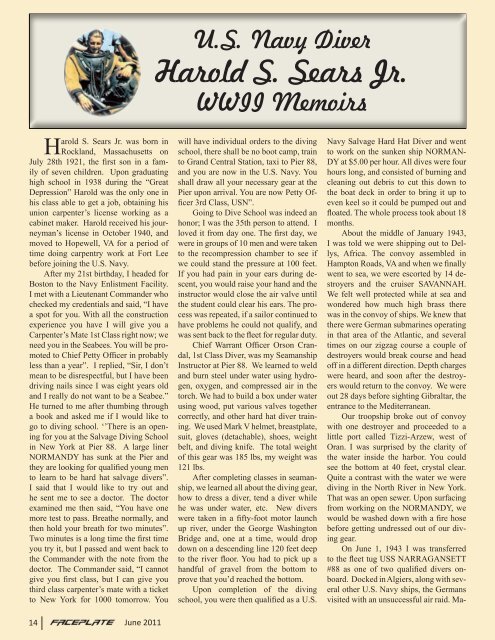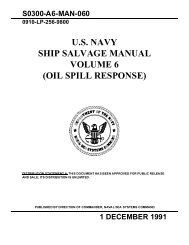June 2011 - Supervisor of Salvage and Diving
June 2011 - Supervisor of Salvage and Diving
June 2011 - Supervisor of Salvage and Diving
You also want an ePaper? Increase the reach of your titles
YUMPU automatically turns print PDFs into web optimized ePapers that Google loves.
U.S. Navy Diver<br />
Harold S. Sears Jr.<br />
WWII Memoirs<br />
Harold S. Sears Jr. was born in<br />
Rockl<strong>and</strong>, Massachusetts on<br />
July 28th 1921, the first son in a family<br />
<strong>of</strong> seven children. Upon graduating<br />
high school in 1938 during the “Great<br />
Depression” Harold was the only one in<br />
his class able to get a job, obtaining his<br />
union carpenter’s license working as a<br />
cabinet maker. Harold received his journeyman’s<br />
license in October 1940, <strong>and</strong><br />
moved to Hopewell, VA for a period <strong>of</strong><br />
time doing carpentry work at Fort Lee<br />
before joining the U.S. Navy.<br />
After my 21st birthday, I headed for<br />
Boston to the Navy Enlistment Facility.<br />
I met with a Lieutenant Comm<strong>and</strong>er who<br />
checked my credentials <strong>and</strong> said, “I have<br />
a spot for you. With all the construction<br />
experience you have I will give you a<br />
Carpenter’s Mate 1st Class right now; we<br />
need you in the Seabees. You will be promoted<br />
to Chief Petty Officer in probably<br />
less than a year”. I replied, “Sir, I don’t<br />
mean to be disrespectful, but I have been<br />
driving nails since I was eight years old<br />
<strong>and</strong> I really do not want to be a Seabee.”<br />
He turned to me after thumbing through<br />
a book <strong>and</strong> asked me if I would like to<br />
go to diving school. ‘’There is an opening<br />
for you at the <strong>Salvage</strong> <strong>Diving</strong> School<br />
in New York at Pier 88. A large liner<br />
NORMANDY has sunk at the Pier <strong>and</strong><br />
they are looking for qualified young men<br />
to learn to be hard hat salvage divers”.<br />
I said that I would like to try out <strong>and</strong><br />
he sent me to see a doctor. The doctor<br />
examined me then said, “You have one<br />
more test to pass. Breathe normally, <strong>and</strong><br />
then hold your breath for two minutes”.<br />
Two minutes is a long time the first time<br />
you try it, but I passed <strong>and</strong> went back to<br />
the Comm<strong>and</strong>er with the note from the<br />
doctor. The Comm<strong>and</strong>er said, “I cannot<br />
give you first class, but I can give you<br />
third class carpenter’s mate with a ticket<br />
to New York for 1000 tomorrow. You<br />
will have individual orders to the diving<br />
school, there shall be no boot camp, train<br />
to Gr<strong>and</strong> Central Station, taxi to Pier 88,<br />
<strong>and</strong> you are now in the U.S. Navy. You<br />
shall draw all your necessary gear at the<br />
Pier upon arrival. You are now Petty Officer<br />
3rd Class, USN”.<br />
Going to Dive School was indeed an<br />
honor; I was the 35th person to attend. I<br />
loved it from day one. The first day, we<br />
were in groups <strong>of</strong> 10 men <strong>and</strong> were taken<br />
to the recompression chamber to see if<br />
we could st<strong>and</strong> the pressure at 100 feet.<br />
If you had pain in your ears during descent,<br />
you would raise your h<strong>and</strong> <strong>and</strong> the<br />
instructor would close the air valve until<br />
the student could clear his ears. The process<br />
was repeated, if a sailor continued to<br />
have problems he could not qualify, <strong>and</strong><br />
was sent back to the fleet for regular duty.<br />
Chief Warrant Officer Orson Cr<strong>and</strong>al,<br />
1st Class Diver, was my Seamanship<br />
Instructor at Pier 88. We learned to weld<br />
<strong>and</strong> burn steel under water using hydrogen,<br />
oxygen, <strong>and</strong> compressed air in the<br />
torch. We had to build a box under water<br />
using wood, put various valves together<br />
correctly, <strong>and</strong> other hard hat diver training.<br />
We used Mark V helmet, breastplate,<br />
suit, gloves (detachable), shoes, weight<br />
belt, <strong>and</strong> diving knife. The total weight<br />
<strong>of</strong> this gear was 185 lbs, my weight was<br />
121 lbs.<br />
After completing classes in seamanship,<br />
we learned all about the diving gear,<br />
how to dress a diver, tend a diver while<br />
he was under water, etc. New divers<br />
were taken in a fifty-foot motor launch<br />
up river, under the George Washington<br />
Bridge <strong>and</strong>, one at a time, would drop<br />
down on a descending line 120 feet deep<br />
to the river floor. You had to pick up a<br />
h<strong>and</strong>ful <strong>of</strong> gravel from the bottom to<br />
prove that you’d reached the bottom.<br />
Upon completion <strong>of</strong> the diving<br />
school, you were then qualified as a U.S.<br />
Navy <strong>Salvage</strong> Hard Hat Diver <strong>and</strong> went<br />
to work on the sunken ship NORMAN-<br />
DY at $5.00 per hour. All dives were four<br />
hours long, <strong>and</strong> consisted <strong>of</strong> burning <strong>and</strong><br />
cleaning out debris to cut this down to<br />
the boat deck in order to bring it up to<br />
even keel so it could be pumped out <strong>and</strong><br />
floated. The whole process took about 18<br />
months.<br />
About the middle <strong>of</strong> January 1943,<br />
I was told we were shipping out to Dellys,<br />
Africa. The convoy assembled in<br />
Hampton Roads, VA <strong>and</strong> when we finally<br />
went to sea, we were escorted by 14 destroyers<br />
<strong>and</strong> the cruiser SAVANNAH.<br />
We felt well protected while at sea <strong>and</strong><br />
wondered how much high brass there<br />
was in the convoy <strong>of</strong> ships. We knew that<br />
there were German submarines operating<br />
in that area <strong>of</strong> the Atlantic, <strong>and</strong> several<br />
times on our zigzag course a couple <strong>of</strong><br />
destroyers would break course <strong>and</strong> head<br />
<strong>of</strong>f in a different direction. Depth charges<br />
were heard, <strong>and</strong> soon after the destroyers<br />
would return to the convoy. We were<br />
out 28 days before sighting Gibraltar, the<br />
entrance to the Mediterranean.<br />
Our troopship broke out <strong>of</strong> convoy<br />
with one destroyer <strong>and</strong> proceeded to a<br />
little port called Tizzi-Arzew, west <strong>of</strong><br />
Oran. I was surprised by the clarity <strong>of</strong><br />
the water inside the harbor. You could<br />
see the bottom at 40 feet, crystal clear.<br />
Quite a contrast with the water we were<br />
diving in the North River in New York.<br />
That was an open sewer. Upon surfacing<br />
from working on the NORMANDY, we<br />
would be washed down with a fire hose<br />
before getting undressed out <strong>of</strong> our diving<br />
gear.<br />
On <strong>June</strong> 1, 1943 I was transferred<br />
to the fleet tug USS NARRAGANSETT<br />
#88 as one <strong>of</strong> two qualified divers onboard.<br />
Docked in Algiers, along with several<br />
other U.S. Navy ships, the Germans<br />
visited with an unsuccessful air raid. Ma-<br />
14<br />
<strong>June</strong> <strong>2011</strong>

















